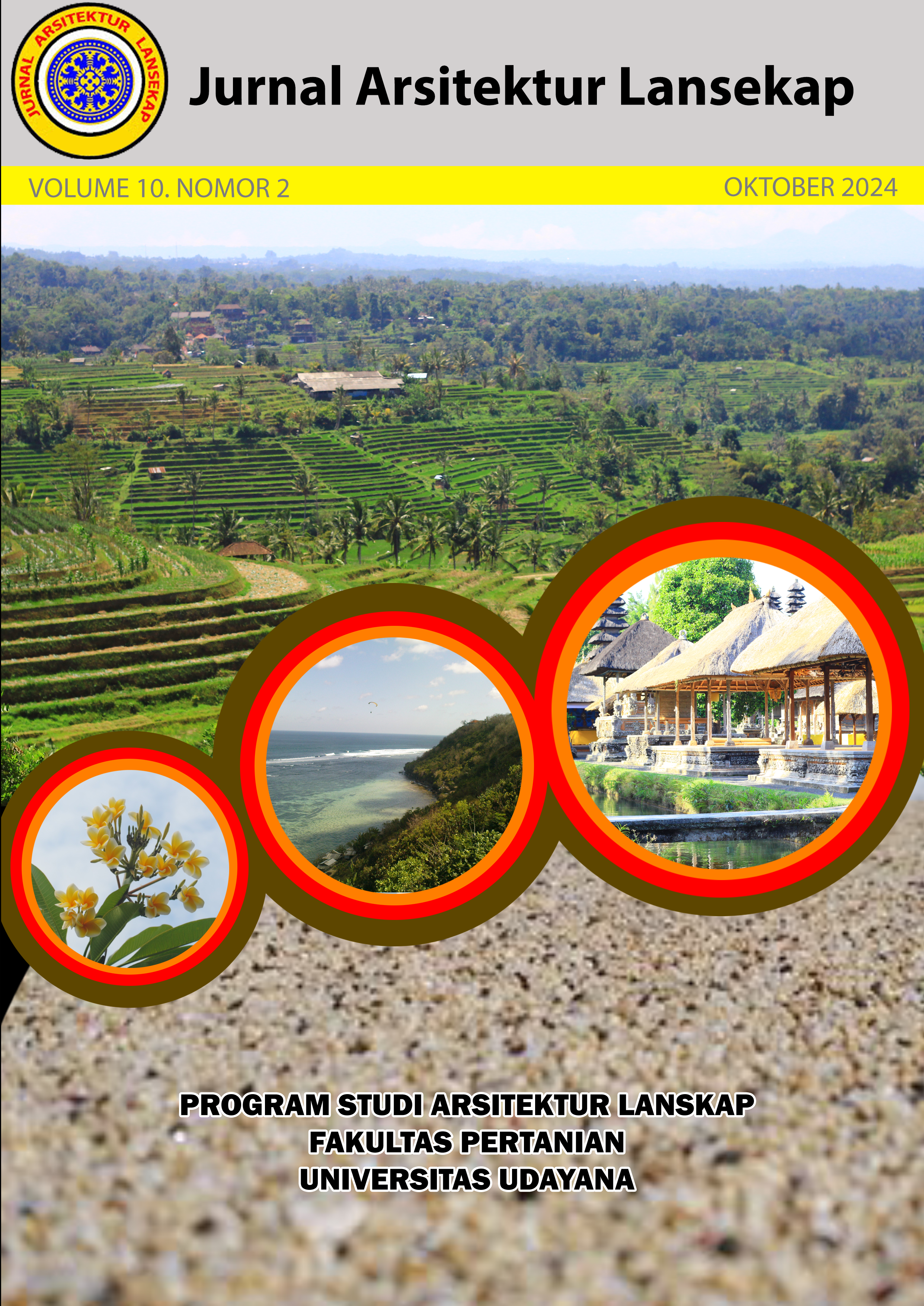Perencanaan Lanskap Saluran Irigasi “Tukad Tanah Putih” di Desa Adat Tegal Darmasaba, Kabupaten Badung sebagai Kawasan Rekreasi
PERENCANAAN LANSKAP SALURAN IRIGASI “TUKAD TANAH PUTIH” DI DESA ADAT TEGAL DARMASABA, KABUPATEN BADUNG SEBAGAI KAWASAN REKREASI
Abstract
The development of river areas can be planned by utilizing the river as a recreation area. Planning development is carried out by utilizing the potentials that exist in the river area, one of the rivers that can be developed its potential is the Tukad Tanah Putih which is located and crosses Badung Regency, Bali. The Tukad Tanah Putih area is an area that is often visited by local people for recreational activities and daily activities, but current conditions are not good in structuring and developing the area such as the unavailability of facilities and infrastructure in the area resulting in damage to physical conditions that make not comfortable in the area for recreation. The Tukad Tanah Putih area is planned as a recreation area that is in harmony with nature and is able to accommodate the community for recreation, with planning space zoning in adapted to the results of regional analysis and synthesis. The research method has been carried out using a survey method with observation, documentation, interviews, and library studies with the stages of inventory, analysis, synthesis, and landscape planning with the aspects studied are biophysical and social aspects. Regional planning resulted in the division of zones, namely active recreation zone, passive recreation zone, and a visual zone, with conservation vegetation and aesthetic vegetation, and planned includes primary circulation and secondary circulation. The results of this study are in the form of recommendations for Tukad Tanah Putih as a recreation area with site plan and ilustrations for each area.
Downloads
References
Badan Pusat Statistik Provinsi Bali. 2020. Hasil Sensus Penduduk 2020 Provinsi Bali. Denpasar: BPS
Badai Penelitian dan Pengembangan Pertanian. 2017. Alat Filter Inlet dan Outlet (FLO) residu pestisida pada Saluran di Petakan Sawah. Balai Penelitian Lingkungan Pertanian diakses pada 19 Oktober 2022. http://www.litbang.pertanian.go.id.
Booth, dan Norman K. 1983. Basic Elements of Landscape Architectural Design. Illinois: Waveland Press.
Ching,dan Francis D. K. 2007. Architecture Form, Space, and Order. New Jersey: John Wiley & Sons.
Gold, dan Seymour M. 1980. Recreation Planning and Design, Mc. Graw Hoill Book Co. New York
Google Earth. 2022. Dam Tanah Putih. Google Earth. Tersedia online pada: https://earth.google.com/web/search/Dam+Tanah+Putih/ (diakses pada: 20 Juni 2022).
Harris, C. W., N. T. Dines. 1998. Time-Saver Standards for Landscape Architecture. Edisi Kedua. McGraw Hill, Publishing Company. United States of America.
Indonesia. 2017. Kementerian Lingkungan Hidup dan Kehutanan. Pedoman Restorasi Kualitas Air Sungai. https://ppkl.menlhk.go.id.
Indonesia. 2006. Peraturan Pemerintah Republik Indonesia PP No. 20 Tahun 2006 tentang Irigasi. Jakarta
Indonesia. 2004. Undang-Undang Nomor 25 Tahun 2004 tentang Sistem Pembangunan Nasional. Lembaran Negara RI Tahun 2004, No. 01. Sekretariat Negara. Jakarta

This work is licensed under a Creative Commons Attribution-ShareAlike 4.0 International License.
An author who publishes in the Jurnal Arsitektur Lansekap (JAL) agrees to the following terms:
- Author retains the copyright and grants the journal the right of first publication of the work simultaneously licensed under the Creative Commons Attribution-ShareAlike 4.0 License that allows others to share the work with an acknowledgement of the work's authorship and initial publication in this journal
- Author is able to enter into separate, additional contractual arrangements for the non-exclusive distribution of the journal's published version of the work (e.g., post it to an institutional repository or publish it in a book) with the acknowledgement of its initial publication in this journal.
- Author is permitted and encouraged to post his/her work online (e.g., in institutional repositories or on their website) prior to and during the submission process, as it can lead to productive exchanges, as well as earlier and greater citation of the published work (See The Effect of Open Access).
Read more about the Creative Commons Attribution-ShareAlike 4.0 Licence here: https://creativecommons.org/licenses/by-sa/4.0/.







